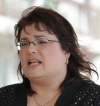Higher indigenous turnout hoped for in provincial vote
Advertisement
Read this article for free:
or
Already have an account? Log in here »
To continue reading, please subscribe:
Monthly Digital Subscription
$1 per week for 24 weeks*
- Enjoy unlimited reading on winnipegfreepress.com
- Read the E-Edition, our digital replica newspaper
- Access News Break, our award-winning app
- Play interactive puzzles
*Billed as $4.00 plus GST every four weeks. After 24 weeks, price increases to the regular rate of $19.00 plus GST every four weeks. Offer available to new and qualified returning subscribers only. Cancel any time.
Monthly Digital Subscription
$4.75/week*
- Enjoy unlimited reading on winnipegfreepress.com
- Read the E-Edition, our digital replica newspaper
- Access News Break, our award-winning app
- Play interactive puzzles
*Billed as $19 plus GST every four weeks. Cancel any time.
To continue reading, please subscribe:
Add Free Press access to your Brandon Sun subscription for only an additional
$1 for the first 4 weeks*
*Your next subscription payment will increase by $1.00 and you will be charged $16.99 plus GST for four weeks. After four weeks, your payment will increase to $23.99 plus GST every four weeks.
Read unlimited articles for free today:
or
Already have an account? Log in here »
Hey there, time traveller!
This article was published 17/03/2016 (3514 days ago), so information in it may no longer be current.
OTTAWA — First Nations voters in Manitoba turned out in huge numbers for last fall’s federal election, and hope is high the increased engagement will be replicated during the provincial election.
On election day last October, anecdotal evidence was flying about long lines to vote on First Nations, and at least six First Nations are believed to have run out of ballots because turnout increased so much over the previous election.
Voters are not identified by ethnicity at the polls, so the only way to analyze turnout among First Nations voters is to look at turnout on reserves. A Free Press analysis of turnout on 42 of Manitoba’s 63 First Nations found turnout increased in all but seven, and the average increase was 56.5 per cent.
In St. Theresa Point, turnout more than tripled to 67 per cent in 2015 from 20.6 per cent in 2011. Turnout more than doubled in five others and was up more than 50 per cent in another 14.
In Churchill-Keewatinook Aski, home to 33 of the 63 First Nations and where about three in every four voters are indigenous, turnout remained the lowest of all Manitoba ridings. However, at 58 per cent, it jumped significantly from the 44 per cent turnout four years earlier. An additional 10,000 votes were cast in Churchill compared with the 2011 election.
In Winnipeg Centre, where about one-fifth of voters is indigenous, turnout jumped 25 per cent.
These results were not unique to Manitoba, with other analyses showing significant jumps in turnout across the ridings with the largest indigenous populations across the country.
Niigaan Sinclair, head of the native studies department at the University of Manitoba, said the poor relationship between the previous Conservative government and First Nations in Canada drove a lot of people to change their mind about voting in federal elections.
“(Stephen) Harper made a very politically aware body of indigenous people,” said Sinclair.
He said at the same time as there was a desire to replace the existing government with one that would be more friendly to indigenous people, there was also suddenly more than one option.
Sinclair said both the NDP and the Liberals included a lot of indigenous issues in their platforms. In past elections “it was very easy to feel apathetic,” said Sinclair.
Last fall’s turnout was also partly due to the awaking of political engagement of young indigenous people in Canada during the Idle No More movement in 2013.
Sinclair said initially he wasn’t certain this would carry over into the provincial election, but now he thinks it will.
“The level of engagement of indigenous candidates has created a buzz,” he said.
There are currently seven indigenous candidates on the ballot for the Liberals, six for the NDP and five for the Conservatives. Not all the nominations are finished, and the NDP could add another candidate if Nahanni Fontaine wins the nomination in St. John’s.
Sinclair said the three main issues concerning First Nations voters in Manitoba all fall into provincial jurisdiction — resource development, the health and safety of indigenous women and child welfare.
mia.rabson@freepress.mb.ca












